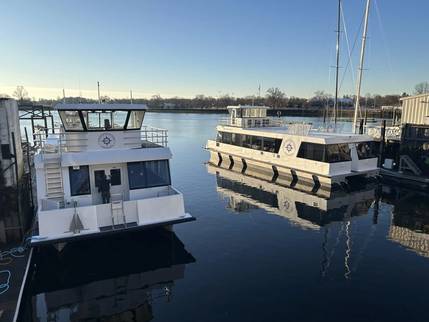Learn to Weld with a Virtual Personal Trainer
The Fohnsdorf Training Center is located in Styria, Austria. To train welders, it uses a virtual welding system – the Virtual Welding simulator from Fronius, the Austrian technology leader. The simulator employs a virtual trainer to provide 1:1 training for the center’s students, an approach that has a positive impact on training quality.
A young student carefully guides the welding torch. The weaving motions she makes as she welds the single-V butt weld in front of her appear very composed, an impression that is confirmed by the consistently positive feedback from her trainer. A colleague next to her practices welding a pipe, and he too has a trainer looking permanently over his shoulder. Students on the welding training course at the Fohnsdorf Training Center have access to five such “personal trainers”. However, these are not real people; they are all totally virtual.
Latest teaching methods ensure success
The Fohnsdorf Training Center is one of the most modern and innovative professional training establishments in Austria. Situated in Murtal in Styria, it has been operating on behalf of the Employment Agency since 1975 to provide specialist staff for commerce and industry. Its emphasis on practical experience and ability to adapt to the requirements of business enable it to broadly fulfill its objective of integrating its students as quickly as possible into the country’s labor market. A success rate of 53.4% in 2016 was the highest in Austria.
The training courses on offer cover the metal technology, electrical engineering, tourism and office/IT sectors, plus the more generic areas of CAD, languages, transport and logistics. Around 1500 students pass through every year and acquire new opportunities in the workplace through training, higher qualifications and professional reorientation. They are supported in their endeavors not only by 170 highly qualified employees, but also by the latest teaching methods. The Fohnsdorf Training Center utilizes various digital approaches, such as e-learning, blended learning and e-testing, to provide the students with state-of-the-art training facilities.
Its desire to keep up to date with the latest developments and maintain the high quality of its training led to the addition of two welding simulators to the Center’s training operations in 2010. “We had a look at Virtual Welding when Fronius exhibited it at the 2009 fair in Essen. We recognized that virtual welding would assist and fundamentally change the training program, so we thought about how we could implement it and purchased our first two simulators in April 2010,” explained Gerhard Zuber, head of the welding technology/transport department at the Fohnsdorf Training Center. Initially, Virtual Welding was primarily used to assess the suitability of students interested in a welding course. “This allowed us to examine their basic handling skills and suitability for the course without first having to go through the in-depth safety training that would be necessary in a real welding environment,” is just one of the advantages of virtual welding picked out by Zuber. Virtual Welding was then gradually introduced into the training program; there are now five welding simulators in use at Fohnsdorf.
Virtual trainer improves quality
The Fronius Virtual Welding system is a welding simulator that allows users to learn and practice the use of various welding processes in a virtual reality (VR) environment. The currently available processes are manual arc welding, gas metal arc welding (MIG/MAG) and, a recent addition, tungsten inert gas welding (TIG). Single-V butt welds, fillet welds, square butt welds, pipe joints and overlay welding can all be practiced in various positions using plastic workpieces attached to the stand-up terminal. A welding torch is used to create a seam that is displayed in real time on the simulator’s touchscreen display and the 3D glasses worn by the user.
“Ghost”, the virtual trainer, is a huge asset when learning how to handle the torch. It shows the path the torch should take and indicates the correct speed, angle and distance between torch and workpiece, giving direct, visual feedback when the student starts to drift away from one of the set values. “A real trainer can explain and demonstrate torch guidance and subsequently provide feedback, but they cannot be everywhere at once. The virtual trainer, on the other hand, is always there. It demonstrates and at the same time gives direct, unequivocal feedback,” is how Zuber explains the main advantage of this training method. At the more advanced levels, welding is unguided, in other words the Ghost does not show the correct torch path. However, even here it offers support in the form of a playback function in which users can see not only their weld, but also review the complete welding operation. Feedback is provided by displaying the torch path taken by the user and the recommended one at the same time so they can be directly compared.
The one-on-one training facility and the ability to carry out “virtual practicing” has transformed welding training in Fohnsdorf, as the highly material-intensive early stages of imparting the basic skills and torch guidance can now be simulated, resulting in savings in resources and costs. The risk of injury is also reduced, as students are trained in how to handle the torch before being confronted by high levels of heat and a dazzling arc. However, the most important aspect is the effect on learning. Zuber highlights the main benefits for the students as follows, “We believe that Virtual Welding makes a significant contribution towards improving training quality. The Ghost provides every student with one-on-one tuition and immediate visual feedback, something that a real-life trainer is simply unable to do. Each new task is first practiced in a virtual environment before being tried out in earnest. This allows the trainer to focus on improving the level of knowledge of welding itself.” Virtual welding helps save time, as there is no need for any pre- or post-processing of workpieces during the initial stages of learning a new process. The Fohnsdorf Training Centre uses the time saved to intensify the training by providing more time to practice and to weld more demanding workpieces.
Intuitive learning makes training fun
The students have generally responded very favorably to Virtual Welding. “We notice amongst younger students in particular a playful enthusiasm in their approach to the subject. They see it as something new, something they’re keen to try out, and use the touchscreen without any inhibitions.” However, it’s when the rankings appear, which display the percentage points awarded for torch guidance that Virtual Welding starts to generate something of a computer game atmosphere. “We don’t actively encourage competition, it’s just that the rankings at the end of an exercise motivate some of the students to try to improve their position. What they’re actually doing is giving their handling skills a massive boost,” comments a delighted Gerhard Zuber about the incentive that virtual welding also offers. Another didactic feature observed by the head of department is that the learning process with Virtual Welding is highly intuitive. “Following a brief explanation of how the simulator works, we simply encourage our students to start welding. The feedback provided by the Ghost shows how the torch should be held and guided. The learning is so subtle that when a student picks up a torch to start doing some real welding, it is held correctly almost by instinct. It’s as if the students are unaware that they’ve already acquired this skill during their highly productive training sessions on the virtual welder.”
Partnership as basis for further development
The valuable experience acquired by the Fohnsdorf Training Center has made it an important partner for Fronius in the further development of Virtual Welding. Zuber hints at more collaboration in the future, “When we commissioned our first two systems in 2010, we were able to feed our experiences and requests back into the development process – a chance that we grabbed with both hands. We remain in close contact with Fronius and still have plenty of ideas about how to extend Virtual Welding and broaden its usage in a training environment.” An increase in the number of “virtual trainers” for welding training has already received the green light. An additional simulator, which will also offer TIG welding, was added to the line-up in 2017, enabling the Fohnsdorf Training Center to better address the requirements of industry. After all, what is the purpose of a personal trainer if not to get you fit – in this case fit to cope with the demands of industry.














